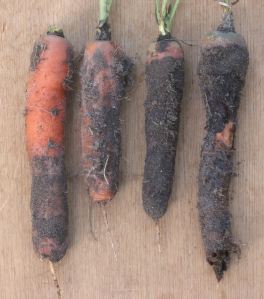By Nathan Smith
Taxonomy can often present itself as fixed fact; a sturdy rock in the uncertain storm of science. However this is not always the case, especially in understudied groups such as fungi. For example, Tuberculina a genus of fungus that parasitizes rust fungi. Rusts, such as Coffee leaf rust, Asian soybean rust, and wheat stem rust, are plant pathogens with major economic impact and Tuberculina was seen as a potential biocontrol agent for their management.
Helicobasidium, on the other hand, is responsible for violet root rot, causing root rot, yellowing, and in extreme cases death of the host. It has a wide host range including apple, sugar beet, soybean, potato, cotton, peanuts, tea, plum, grape, and carrot. More than 24% of planted acres of sugar beet in the USA have economic damage caused by violet root rot with the losses being as high as 50%.
It appears then that Tuberculina is a genus that can be used beneficially and should be encouraged in crop fields whereas Helicobasidium should be controlled against and excluded where possible. There’s just one problem: they are the same genus.
These ostensibly separate genera actually represent different stages in the fungal life cycle. Tuberculina and Helicobasidium samples were found to have morphological and genetic similarity. Most importantly, inoculation of a host with Helicobasidium spores was capable of causing a Tuberculina infection.
Tuberculina is proposed to form an amplification stage, where the fungus produces large amounts of genetically identical conidia. The fungus then enters dormancy and the Helicobasidium stage where sexual reproduction takes place, allowing the fungus to remain genetically diverse.
That Tuberculina and Helicobasidium are one and the same is strong evidence for the argument against the use of the fungus as a biocontrol. However, for some Tuberculina species, an equivalent Helicobasidium-stage could not be found. It’s possible that some Tuberculina could have completely abandoned the sexual Helicobasidium stage. If this is the case, Tuberculina may still have potential as a biocontrol agent, although this would require extreme caution.
Fungi are critically under-studied as a kingdom and basic research into their various life-cycles is much needed if we are to effectively control fungal diseases and manipulate fungi for our own benefit. The Jekyll and Hyde characteristics of Tuberculina/Helicobasidium show this clearly and, without fundamental fungal research, we could all too easily still be supporting the traitor in our midst.
See the original paper on Tuberculina and Helicobasidium here.


This will be good for environment because biological control measures do not pollute the environment.
Thank you.
Although Cate is quite right to consider biological control a very good thing I wondered if the statement that it was good for the environment is always correct.
My mind went to Bacillus thuringensis. I have no personal issue with this efficient caterpillar killer but some people consider – wrongly I think – that the toxins contained in the commercial product used on a vast scale in world agriculture are not a good thing. Others might worry that a bacteria that attacks caterpillars might not be very good for pretty butterflies